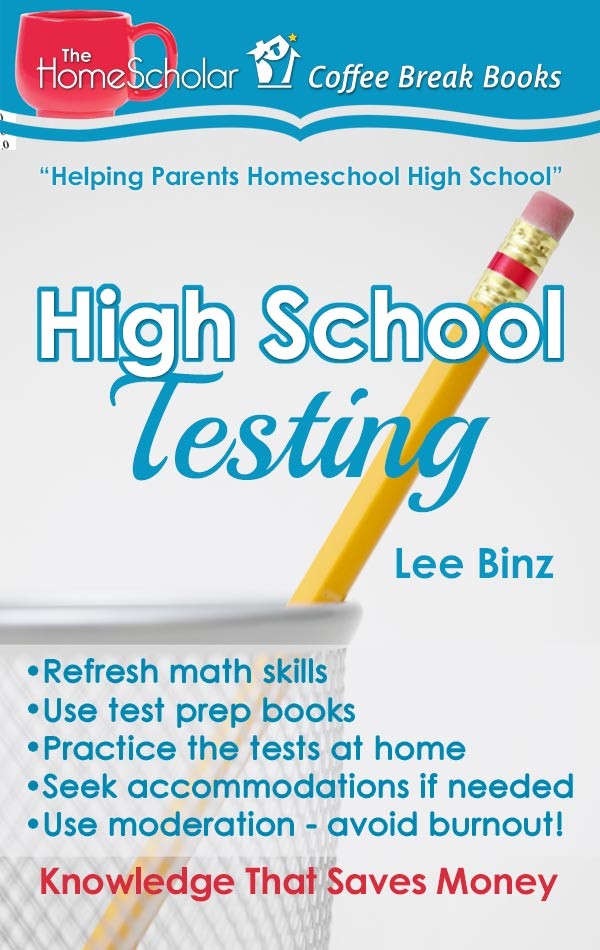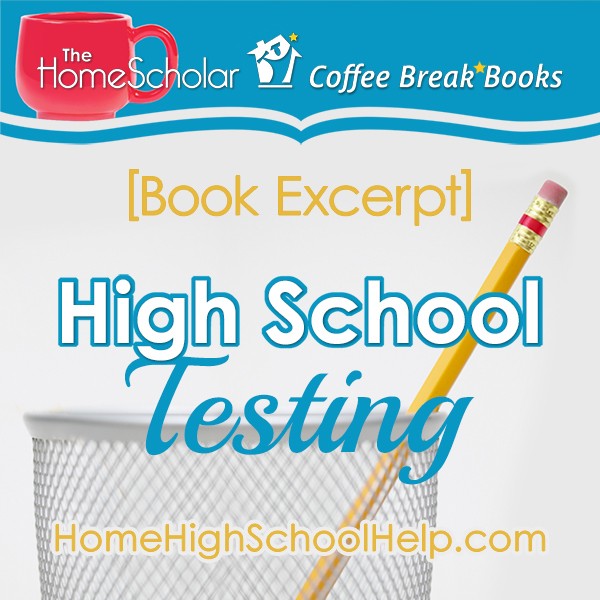[Book Excerpt] High School Testing
~ A word from our founder, The HomeScholar Emeritus, Lee Binz ~
This is a chapter from my book, High School Testing: Knowledge That Saves Money. You can purchase a copy in print or Kindle version on Amazon.
Study for the SAT®
Studying for a college entrance exam is worthwhile for most college-bound high school students. It's not a waste of time! Research has shown that preparation can increase SAT® scores by 100 points. Better SAT® scores can increase your child's chances of earning college admission and academic scholarships. Making test preparation a regular part of your high school experience will make it much easier for your student to succeed. Public school students may have trouble finding time to prepare for the test, but it can be a part of your homeschooler's total educational experience.
Like many homeschool parents, I understood that studying for the SAT® test was necessary for college admission and financial aid but was frustrated that I had to "teach to the test." My teenagers were also resistant. But the tests measure basic skills and of all the things I wanted my children to learn, reading, writing, and math were high on the priority list. Now that we are on the other side, we can all see the benefits of preparation!
- High scores helped my children earn great scholarships.
- They learned important essay writing skills.
- They mastered math concepts from basic to advanced.
- They gained confidence in their test-taking abilities.
The Basics
The SAT® is a standardized college entrance exam with two sections that measure evidence-based reading and writing, and math skills. Each section is graded on a 200-800 scale. For each section, a grade of 500 is average, 600 is good, 700 is great, and 800 is perfect. Because there are two sections, a perfect score on the SAT® is 1600. Prior to the newly designed SAT®, a perfect score was 2400 because there were three sections. The test takes three hours, plus 50 minutes for the optional essay section, and is given at local high schools and some colleges. For more information, go to www.collegeboard.com.
Refreshing math skills can be helpful for a struggling student who might benefit from a regular review of concepts. Math review will also help an advanced student, who may not have gone over beginning concepts for many years. The reading section includes vocabulary students need to know to succeed in college. Instead of buying a vocabulary curriculum, you can use SAT® preparation for your homeschool vocabulary studies.
I must confess that the essay is my favorite part of the test. Essay writing is crucial to success in college. My youngest son thanked me for teaching him how to write a typical test essay.
Tools to Prepare
Before high school begins, you can prepare for the SAT® by providing a quality education that includes reading, writing, and arithmetic. Penmanship is important as well, since part of the SAT® is an optional hand-written essay seen by colleges. Homeschooling parents have the advantage on the SAT® test when they provide a quality, well-rounded education for their child.
But how does a high school student prepare for such a test? There are some great test prep books, but I prefer the ones from The Princeton Review. I feel they have a youthful, conversational style that appeals to teenagers more than the dry, "business only" approach of other books. I used the book, Cracking the SAT® by The Princeton Review. It has a short, easy to understand explanation of the test, and includes four complete exams. All the answers provide clear explanations.
In our homeschool, we completed one section of one practice test at a time. Each section is 25 minutes long. We used a timer to simulate a real testing environment. After completing a section, my children corrected their tests by themselves, and looked over the explanation of each wrong answer.
If they still had questions, my husband went over the explanation with them. For more practice, check out 500+ Practice Questions for the New SAT® by The Princeton Review. It has a section on what to expect in the new SAT® along with many practice questions. The focus of this book is only sample questions. It gives clear, concise answers and explanations for every problem.
For students who need more essay writing practice, check out the AP® English Language and Composition free response questions; the prompts make perfect practice for the SAT® essay section. You can find sample free response questions on the College Board's AP® English Language and Composition page. In fact, the AP® English Language and Composition exam makes a great ACT®/SAT® prep course when taken in junior year.
For more SAT® math, reading, writing, and essay practice, you can also visit the Khan Academy website at khanacademy.org/sat. In cooperation with the College Board, Khan Academy offers free information, practice tests, quizzes, video lessons, and hints.
Other kinds of test preparation can also increase scores and yield great dividends. Some students learn better without textbooks. For the reading and writing section, you can prepare your child using a "real books" approach. Reading quality literature is the best preparation.
Many test preparation companies offer classic literature that highlights SAT® vocabulary words. Kaplan publishes a series of books called SAT® Score-Raising Classics. They are books such as Frankenstein, Wuthering Heights, and The Scarlet Letter with the text on one side of the page and vocabulary words in bold print. On the other side of the page, each word in bold is defined in simple terms. We used these books as a part of our regular curriculum choices, and they doubled as SAT® preparation. I read aloud, and my children read the vocabulary definitions over my shoulder as we went along.
Auditory learners might prefer the Verbal Advantage program for vocabulary development, with its audio CDs and CD-ROM guidebooks. There are also SAT® prep video tutorials available through Standard Deviants (www.standarddeviants.com) and The Teaching Company that can provide vocabulary and math review for visual learners.
Practice Might Make Perfect
You can enroll your child in a formal SAT® class at home, using a variety of online courses through test preparation companies such as the College Board, Kaplan, or The Princeton Review. This may be a good option for a student who is a visual or auditory learner, or a student willing to do anything if it's on the computer. Your child can also take classes through a co-op (usually inexpensive) or a private course (usually pricey).
Our local library offered a practice test twice a year, through The Princeton Review. It was the most realistic practice we found, because it was a real test in a real test situation, graded so we had an objective score for each child. The SAT® is such a long test that we were thankful our kids could try it in a safe environment before they took it for real.
Studying for the SAT® can benefit your homeschool, but it's possible to go overboard. Studying for hours a day, for weeks on end may cause burnout. The last thing you want is to frustrate your teenager so much that they hate homeschooling. You want them to learn test-taking skills and reinforce basic skills but do it with a light touch. Know your student and trust your own judgment.
Accommodations for Homeschoolers
If your child struggles with learning challenges, it may be helpful to get an official diagnosis, and then pursue accommodation on the SAT®. Accommodation requires a recent diagnosis from a doctor, and there are specific rules that must be followed.
If the essay is a stumbling block, you can also opt for the SAT® or ACT® test without the optional essay. The SAT® or ACT® work equally well for college admission. If you decide to avoid the essay, you can instead have your child take plenty of time on the college application essay, perhaps even explaining their difficulty with writing.
Look over the Dragon Naturally Speaking software to see if it can be a solution to help your child write college application essays and in other areas of school. Check the College Board Services for Students with Disabilities for more on accommodations.
High School Testing is one of my Coffee Break Books. What are Coffee Break Books? These are books designed for YOU - a busy homeschool parent feeling frustrated by something, and needing information NOW - all put together in an easy-to-read, short, simple format. Coffee Break Books are perfect for overwhelmed, sleep-deprived moms with a baby on their hip. Simple, large font makes them easy to read even when distracted or pulled in a million directions. They are designed to help parents tackle just ONE issue of homeschooling during just ONE coffee break! Each book combines a practical and friendly approach with detailed, easy-to-digest information. Never overwhelming, always accessible and manageable, each book in the series will give you the tools you need to tackle the tasks of homeschooling high school, one warm sip at a time.
Learn more about High School Testing in my video review below!
This is a chapter from my book, High School Testing: Knowledge That Saves Money. You can purchase a copy in print or Kindle version on Amazon.
When you subscribe to the blog, we will send you an e-mail when there are new updates on the site so you wouldn't miss them.

 Login
Login










.jpg)

Comments